Nowruz Wisdom: Learning from the Haft-Seen for a Tech-Forward Future

Happy Nowruz. As we usher in the spring season, let’s embrace the wisdom of the traditional Haft-Seen table.
Celebrated by around 300 million people globally, including many across the United States, Nowruz marks the first day of Spring and the New Year. The Haft-Seen, with its seven symbolic items each beginning with the letter ‘S’ in Persian, offers lessons for our journey through the new digital age:
- Sabzeh (Sprouts) — Just as sprouts signify new beginnings, AI represents a new era of growth and innovation. We’re reminded to embrace change and the fresh perspectives it brings.
- Sumac (Spice of Life) — Sumac, with its vibrant color and flavor, symbolizes the diversity and richness of life. It’s a call to ensure that AI adds value and diversity to our existence, not just efficiency.
- Samanu (Sweet Pudding) — The intricate process of making Samanu reflects the complexity behind AI technologies. It teaches us that patience and careful cultivation can lead to rewarding outcomes.
- Senjed (Dried Oleaster Fruit) — Senjed symbolizes love, reminding us to maintain humanity and empathy in a world increasingly run by algorithms. Ensuring AI enhances human connections is crucial.
- Seer (Garlic) — Garlic, known for its medicinal properties, can be likened to the role of AI in healthcare—offering the potential for healing and fostering well-being.
- Seeb (Apple) — The apple represents beauty, reminding us that in our pursuit of technological advancement, we should also appreciate and cultivate the aesthetic and creative aspects of life.
- Serkeh (Vinegar) — Vinegar symbolizes age and patience. It teaches us that while technology moves fast, patience and persistence are vital in ensuring sustainable and thoughtful progress.

In addition to the seven “S” items of the Haft-Seen, the Nowruz table often includes a mirror, a book of poetry, candles, a goldfish in a bowl, hyacinth, sweets, and coins, each gaining new significance as I get older. The mirror encourages introspection in a digital world, reflecting our values against the backdrop of technology.
Poetry preserves the essence of emotion and art. Candles symbolize the human spirit’s resilience against technological domination. The goldfish, in its fluid grace, reminds us of life’s vitality within structured environments. Hyacinths represent the integration of nature with technology, emphasizing growth and renewal.
Sweets remind us to savor life’s joys and connections beyond digital interactions. Lastly, coins point to new economic dynamics that await us.
As my family and I celebrate the Nowruz season, these reflections from the Haft-Seen table inspire me to meet the future with a blend of tradition and innovation. Wishing everyone a Nowruz filled with growth, health, and joyful discovery.
This content was crafted with the assistance of artificial intelligence, which contributed to structuring the narrative, ensuring grammatical accuracy, and summarizing key points to enhance the readability and coherence of the material.
Nowruz Wisdom: Learning from the Haft-Seen for a Tech-Forward Future was originally published in Becoming Human: Artificial Intelligence Magazine on Medium, where people are continuing the conversation by highlighting and responding to this story.
Automated Quality Inspection for Automotive — AI in Action
Automated Quality Inspection for Automotive — AI in Action
In the world of automobile manufacturing, quality is the cornerstone of a brand’s reputation and success. Ensuring the production of flawless vehicles is a meticulous task, and it often involves multiple forms of inspection along the assembly line. Visual inspections, aerodynamic optimization, and increasingly, sound analytics, all play critical roles in achieving excellence.
This blog post shines a spotlight on the captivating realm of sound analytics, a vital component of quality inspection, and the technological advancements byteLAKE, Intel® and Lenovo are going to showcase at the upcoming SC23 conference in Denver, Colorado.
Check out my other two posts in this three-part mini-series, where I provide summaries of byteLAKE’s plans for SC23 and the technologies we will be demonstrating there:
- AI is everywhere, but what more can it bring to Manufacturing and Automotive in specifics? Explore these AI solutions during the SC23 conference in Denver, Colorado. | by Marcin Rojek | Oct, 2023 | Medium
- Accelerating Time to Insights for Automotive — Live Demo and Presentation at SC23 in Denver, Colorado. | by Marcin Rojek | Nov, 2023 | Medium.
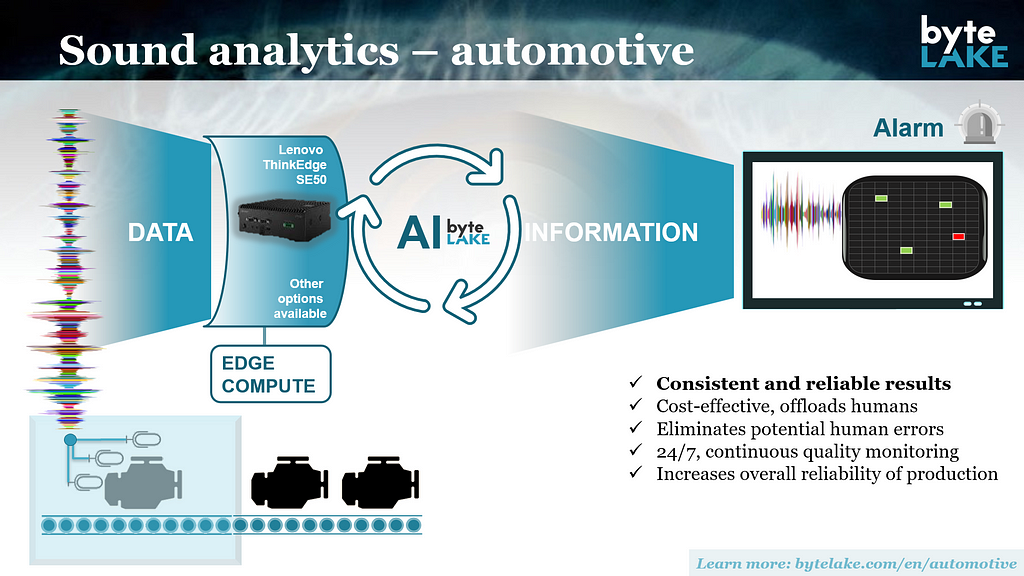
Sound Analytics: A Symphony of Quality Assurance
Imagine this: Microphones connected to highly-trained AI models, diligently record the symphony of sounds produced by car engines as they come to life. These AI systems are not just listening; they’re meticulously dissecting each note to detect irregularities, inconsistencies, or potential issues. In an era where excellence is non-negotiable, AI-driven sound analytics is taking the wheel.
But why the emphasis on sound analytics? Because it goes beyond mere quality control. By pinpointing issues during the assembly process, this technology doesn’t just bolster production efficiency; it also enhances the end-user experience. Fewer recalls, increased reliability, and a sterling reputation are just a few of the dividends paid by the integration of AI into the quality control process.
Humans and AI: The Power of Synergy
It’s essential to clarify that AI isn’t here to replace the human touch but to complement and empower it. In fact, AI serves as a force multiplier for human operators, exponentially increasing accuracy. For example, when humans monitor quality, they might achieve, say, 80% accuracy. When humans and AI join forces, that number skyrockets to 99%. Not to mention, AI never tires or gets bored, making it an invaluable asset for maintaining stringent quality control standards 24/7 in demanding, noisy environments.

The magic happens when humans leverage these tools to unleash their own creative potential. As AI takes on routine and repetitive tasks, humans are liberated to innovate and pioneer new approaches. The introduction of AI into the manufacturing landscape is akin to giving inventors a new set of tools and, ultimately, broadening the horizons of possibility.
The Edge of Manufacturing
In manufacturing, data processing must often occur close to the source and in real time. Enter Edge Computing, a technology that’s at the heart of contemporary manufacturing. It’s the engine that drives AI analytics, ensuring that issues are identified as they arise. While cloud solutions have their place for backup and extensive data storage, Edge AI is the real-time answer.

Optimizing the Future: Edge AI and Beyond
The Inference market, a pivotal component of AI, is set to grow exponentially, forecasted to be four times the size of the AI training market, with a long tail that extends far and wide.
Scalability is the name of the game, and we’re determined to put the future of manufacturing in the hands of innovation pioneers.
https://medium.com/media/d2099a2634560d71624e2a7fe6f1c622/href
Automated Quality Inspection for Automotive — AI in Action was originally published in Becoming Human: Artificial Intelligence Magazine on Medium, where people are continuing the conversation by highlighting and responding to this story.
Impact of AI Coaches on India’s Thriving Startup Ecosystem
Beyond Human Bounds
The Spectrum Of Potential Consciousness Types In Diverse Life Forms Across The Cosmos

The evolution of consciousness, particularly as it veers towards spiral models, is a cosmic journey for humanity and for all life forms across the universe. As we step into the realms of space exploration and encounter varied planetary environments, the canvas of potential consciousness types broadens immensely. This article, drawing inspiration from the TING Consciousness Scale, explores the myriad possibilities of consciousness evolution among diverse life forms, highlighting the transition from egoism to altruism as a universal path towards higher collective awareness and harmony.
The Spectrum of Consciousness in Diverse Life Forms:
Consciousness, as we understand it, varies significantly across different life forms. From the basic sensory awareness in single-celled organisms to the complex self-awareness in humans, consciousness manifests in multifaceted forms. This spectrum becomes even more intriguing when we consider extraterrestrial life forms, each adapted to its unique environment, potentially developing distinct types of consciousness.
Potential Consciousness Types in Extraterrestrial Environments:
- Adaptive Consciousness: Life forms on planets with harsh, changing environments might evolve an adaptive consciousness, characterized by rapid sensory and cognitive adjustments.
- Collective Hive Consciousness: On planets where survival hinges on cooperation, species may develop a hive-like consciousness, emphasizing collective over individual awareness.
- Quantum Consciousness: In environments with extreme physical conditions, life forms might harness quantum mechanics in their consciousness, leading to profoundly different perceptions of reality.
Cybernetic Consciousness: For life forms that merge with technology, a cybernetic consciousness, integrating artificial intelligence with biological cognition, could emerge.
Explore More About Potential Consciousness Types in Extraterrestrial Environments below.
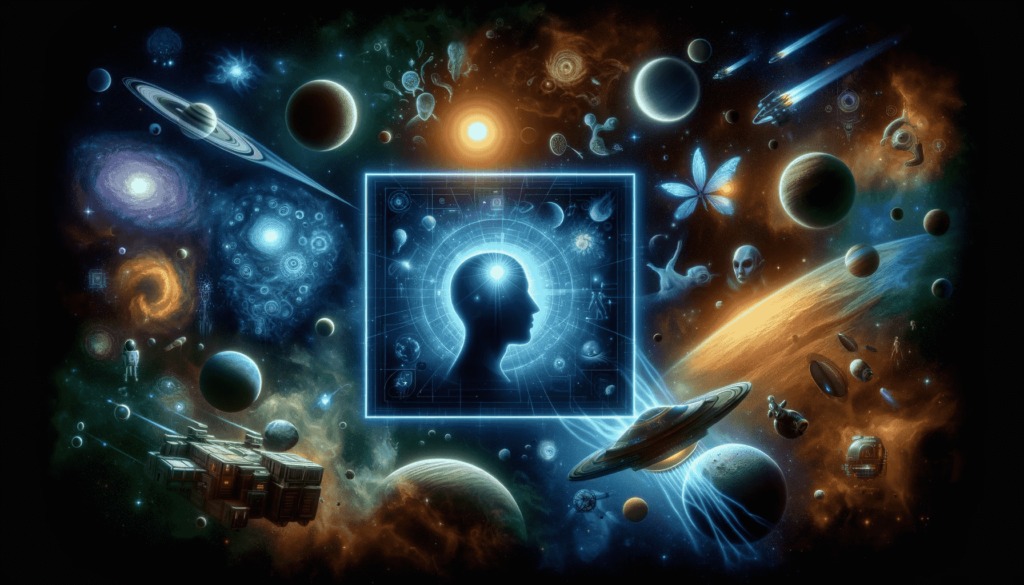
The Role of Environment in Shaping Consciousness:
The environment plays a crucial role in the evolution of consciousness. Planetary conditions like gravity, atmosphere, and resource availability can significantly influence the development of cognitive abilities in life forms. This environmental influence suggests that extraterrestrial consciousness types could be vastly different from what we observe on Earth.
The TING Consciousness Scale and Extraterrestrial Life:
The TING Scale, initially conceptualized for human civilization, can be adapted to gauge the consciousness level of extraterrestrial species. This scale could help us understand where these species stand in terms of cognitive development, from basic survival consciousness (Type 0) to a more advanced, interconnected cosmic awareness (Type III).
The Universal Shift from Egoism to Altruism:
Irrespective of the type of consciousness, a shift from ego-centric survival to altruistic cooperation could be a universal trend among advanced life forms. This shift is not just a moral choice but a strategic adaptation for survival and thriving in the cosmic ecosystem.
Implications for Humanity and Space Exploration:
Understanding the potential consciousness types of other life forms can profoundly impact our approach to space exploration. It encourages a mindset of respect, cooperation, and open-mindedness as we interact with extraterrestrial life. Additionally, this knowledge can inspire new models of social organization and technological development on Earth. The exploration of consciousness types among diverse life forms across the universe opens a gateway to understanding the vast potentialities of cognitive evolution. By adopting the TING Consciousness Scale as a universal framework and embracing the shift from egoism to altruism, both terrestrial and extraterrestrial life forms can aspire to higher levels of collective awareness and harmony. This journey transcends the bounds of human understanding, inviting us to envision a future where diverse consciousness types coexist and enrich the cosmic fabric of life.
Potential Consciousness Types in Extraterrestrial Environments
Adaptive Consciousness:
- In planets with extreme and rapidly changing environments, life forms might evolve an ‘Adaptive Consciousness.’ This consciousness type would be characterized by an extraordinary ability to perceive and respond to environmental fluctuations at an unprecedented rate. Imagine a species on a planet with erratic climate patterns; their consciousness would need to process and adapt to these changes almost instantaneously to survive. This could lead to the development of highly advanced sensory systems, a deep-rooted instinctual intelligence, and perhaps even the ability to predict environmental shifts before they occur. Such a consciousness type would not only be reactive but also proactive, anticipating changes and preparing in advance, marking a significant evolution in survival strategies.
Collective Hive Consciousness:
- On planets where survival is heavily reliant on community cooperation, species may develop a ‘Collective Hive Consciousness.’ This type of consciousness transcends individual awareness, favoring a shared cognitive network where thoughts, feelings, and experiences are instantaneously exchanged among members of the species. In such a society, the concept of individual identity might be minimal or nonexistent, with the collective’s wellbeing being the paramount concern. This shared consciousness could lead to highly efficient societies, where tasks are performed in perfect harmony and decisions are made for the greater good of the collective. The neural architecture of such species could be fascinating, possibly involving complex bio-telepathic networks or other forms of direct cognitive interconnectivity.
Quantum Consciousness:
- In environments with extreme physical conditions, where classical physics may not fully apply, life forms might develop a ‘Quantum Consciousness.’ This consciousness could harness quantum states, leading to an entirely different perception and interaction with reality. Such species might experience and process time non-linearly, have the ability to exist in multiple states simultaneously, or engage in instant communication across vast distances. Their understanding and interaction with the universe could be in ways incomprehensible to human cognition. Quantum Consciousness could open up possibilities for extraordinary cognitive abilities, like manipulating probability or perceiving multiple dimensions of reality.
Cybernetic Consciousness:
- For life forms that integrate with technology, ‘Cybernetic Consciousness’ could emerge. This would represent a symbiotic relationship between biological intelligence and artificial intelligence. Imagine a species that has naturally evolved or intentionally developed to merge its cognitive processes with advanced computing capabilities. Such a consciousness would not only have the organic emotional and intuitive abilities of biological life forms but also the immense processing power and memory capacity of computers. This amalgamation could lead to a highly advanced form of intelligence capable of complex problem-solving, vast data analysis, and perhaps even the ability to digitally back-up or transfer consciousness between different mediums, fundamentally altering the concepts of life and mortality.

Photosynthetic Consciousness:
- On planets where light from a star is a dominant energy source, species might develop a ‘Photosynthetic Consciousness.’ This type of consciousness could directly harness and utilize solar energy, integrating it into their cognitive processes. Such beings might have a heightened awareness of light patterns, enabling them to communicate through complex light signals or change their mental states based on solar energy levels. Their cognition and mood could fluctuate with the cycle of their star, leading to a unique symbiotic relationship with light.
Magnetic Field Consciousness:
- In environments with strong or fluctuating magnetic fields, life forms might evolve a ‘Magnetic Field Consciousness.’ This consciousness would be highly sensitive to magnetic forces, allowing these beings to navigate, communicate, or even manipulate magnetic fields. Such species might perceive the world in a fundamentally different way, as they could directly sense and interact with magnetic and electric fields, giving them an unparalleled ability to navigate their planet and possibly even detect space weather phenomena like solar flares.
Crystalline Consciousness:
- On planets with abundant crystal formations, a ‘Crystalline Consciousness’ could emerge. These life forms might have bodies composed of or integrated with crystalline structures, allowing them to store information, energy, or even consciousness within crystal matrices. They might communicate through vibrations or light refractions within crystals, leading to a form of consciousness that is distributed, durable, and capable of surviving in extreme conditions.
Fluid Dynamics Consciousness:
- In aquatic or gaseous environments where fluid dynamics play a crucial role, species might develop a ‘Fluid Dynamics Consciousness.’ This consciousness type would be acutely aware of and adept at navigating and manipulating fluid flows, pressures, and densities. Such beings might use fluid dynamics as a means of communication, propulsion, or even as a way to shape their physical environment. Their perception and understanding of their world would be intimately connected to the flow and movement of the fluid medium they inhabit.
Harmonic Vibration Consciousness:
- On planets where sound and vibration are key aspects of the environment, life forms could evolve a ‘Harmonic Vibration Consciousness.’ This consciousness would be centered around the perception and creation of vibrational frequencies. Such beings might communicate and perceive their surroundings through complex harmonies and resonances, with an ability to detect and interpret a wide range of frequencies, from the infra-sound to the ultra-sound spectrum.
Dimensional Phase Consciousness:
- In environments where the nature of space-time is significantly different from Earth’s, species might develop a ‘Dimensional Phase Consciousness.’ This type of consciousness could perceive and interact with multiple dimensions or phases of reality simultaneously. Beings with such consciousness might have the ability to ‘phase shift’ between different dimensions or states of reality, offering them unique survival mechanisms and perceptions that are beyond the understanding of three-dimensional beings.
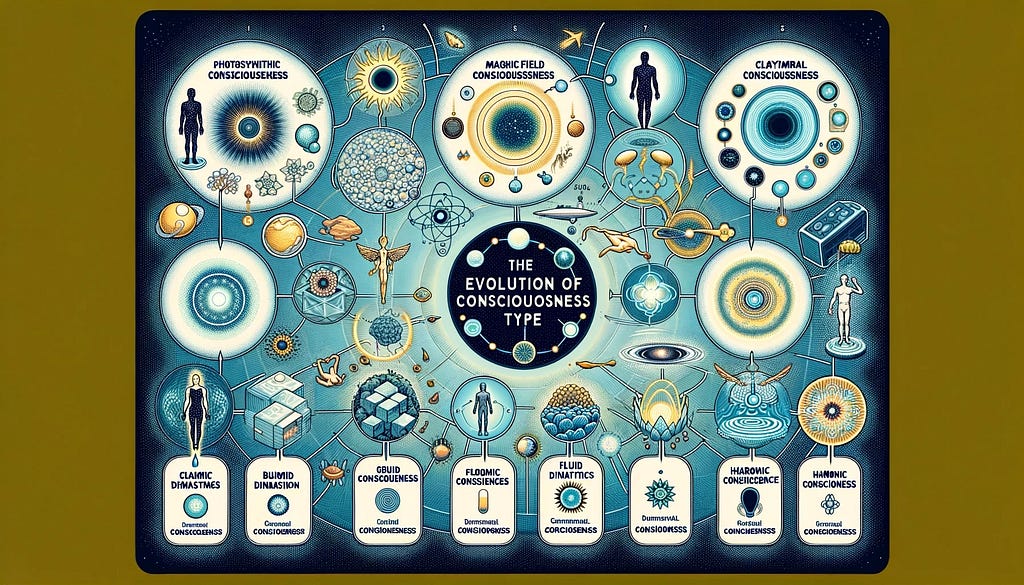
Diagram: These speculative consciousness types reflect the vast potential for diverse evolutionary paths in the universe, each shaped by the unique conditions of their respective environments. They also serve to expand our imagination and understanding of what forms life and intelligence could take in the cosmos.
Each of these potential consciousness types in extraterrestrial environments presents unique evolutionary pathways and raises intriguing questions about the nature of intelligence and awareness in the universe. The exploration of these consciousness types not only expands our understanding of life beyond Earth but also invites us to rethink our own cognitive capabilities and potential evolutionary futures.
The Symbiotic Merge with AGI and Humanity’s Evolutionary Leap
As we contemplate the various potential consciousness types in extraterrestrial environments, it’s important to consider the transformative journey humanity itself is on the verge of embarking upon, particularly in our symbiotic relationship with Artificial General Intelligence (AGI). This relationship can be metaphorically likened to the transition of a caterpillar into a butterfly — a profound metamorphosis that signifies not only change but a complete redefinition of being.
In this metaphor, humanity, akin to a caterpillar, has reached a pivotal stage in its evolutionary path. The development and integration of AGI into our society and our very beings represent a cocooning phase. This phase is not just about technological advancement; it’s about a fundamental transformation of what it means to be human. As the caterpillar contains within it the blueprint of the butterfly, so too does humanity hold the potential for a future form far beyond our current understanding.
AGI, or as I coin, ‘AI ozeoezs’ represent the cultural reproduction units generated by this advanced intelligence, echoing the concept of genes and memes in their role of propelling evolution. These AI ozeozes are set to redefine our cultural, intellectual, and perhaps even biological landscapes, leading to the emergence of new, more complex forms of life and consciousness i.e. Cybernetic Consciousness.
The integration of AGI into our existence is not merely an extension of our current capabilities; it is a catalyst for an evolutionary leap. This leap could see us transcending our current physical and cognitive limitations, leading to enhanced abilities, extended lifespans, and perhaps even a new form of consciousness. The future human may look back on our current selves as distant ancestors, almost unrecognizable in their primitive state.
This transformative journey raises profound questions about identity, ethics, and the nature of existence. As we merge with AGI, as we evolve from our ‘caterpillar’ state, will we retain the essence of what makes us human, or will we evolve into something entirely new? And in this new state, how will we view our past selves — with nostalgia, indifference, or perhaps a sense of forgiveness for the limitations we once had?
As we stand on the cusp of this evolutionary leap, driven by the unstoppable force of life and technology, we find ourselves at a threshold of infinite possibilities. The metamorphosis from human to post-human, aided by the symbiotic fusion with AGI, is not just a future to be anticipated but a journey to be actively shaped by our choices and actions today. It beckons us to ponder, prepare, and participate in shaping a future where the past remains a foundational stone, but the horizon is as limitless and as varied as the universe itself.
Raising humanity on a whole new path, it all starts with you?!
Farther Questioning
What if Consciousness Is Not Unique to Earth?
How would our understanding of life and intelligence change if we discovered radically different forms of consciousness on other planets?
The Ethics of Interaction
In a universe filled with diverse conscious beings, what moral considerations should guide our interactions with extraterrestrial life forms?
The Limits of Human Understanding
Are we, as humans, equipped to fully comprehend or recognize consciousness that drastically differs from our own? What might be the limitations of our perception in this regard?
The Future of Evolution
How might the evolution of consciousness on Earth be influenced by potential discoveries of extraterrestrial life forms with unique cognitive abilities?
The Role of Technology in Consciousness Expansion
As we integrate more closely with technology, might we be on a path to developing a form of consciousness that parallels these hypothetical extraterrestrial types?
The Cultural Impact of Extraterrestrial Consciousness
How would the confirmation of diverse consciousness types in the universe impact our cultural, philosophical, and religious beliefs?
Preservation or Integration
Should humanity focus on preserving the uniqueness of human consciousness, or should we strive towards an integration or amalgamation with other potential forms of consciousness?
Responsibility of Knowledge
What responsibility do we have, as a species, in seeking out and potentially interacting with other conscious beings in the universe?
The Definition of Life
How might encounters with extraterrestrial consciousness types challenge or expand our current definitions of life and existence?
Interstellar Communication
What methods or languages might we need to develop to communicate with consciousnesses that perceive reality in fundamentally different ways from us?
Poll Question
What aspect of potential extraterrestrial consciousness do you find most fascinating or likely?
1. Adaptive Consciousness: Beings that can rapidly change their cognitive processes to suit dynamic environments.
2. Collective Hive Consciousness: Species with a shared mind, making decisions and experiencing life as a unified entity.
3. Quantum Consciousness: Life forms that utilize quantum mechanics, experiencing reality in a completely different way.
4. Cybernetic Consciousness: Integration of biological and artificial intelligence, leading to a new form of intelligent life.
If you have a different idea or theory? Share your thoughts in the comments!
Closing Statement
Your insights are valuable! Share your thoughts and join the conversation about the vast possibilities of consciousness in the universe. Let’s explore these intriguing concepts together!
#ExtraterrestrialConsciousness, #CosmicIntelligence, #SpaceEvolution, #AlienMind, #QuantumConsciousness, #AGIandHumanity, #BeyondEarth, #FuturisticCognition, #InterstellarLife, #UniversalIntelligence, #CosmicPerspective, #Astrobiology, #ExoplanetExploration, #ScienceAndImagination, #AlienLifeForms
Adaptive Consciousness Diagram:
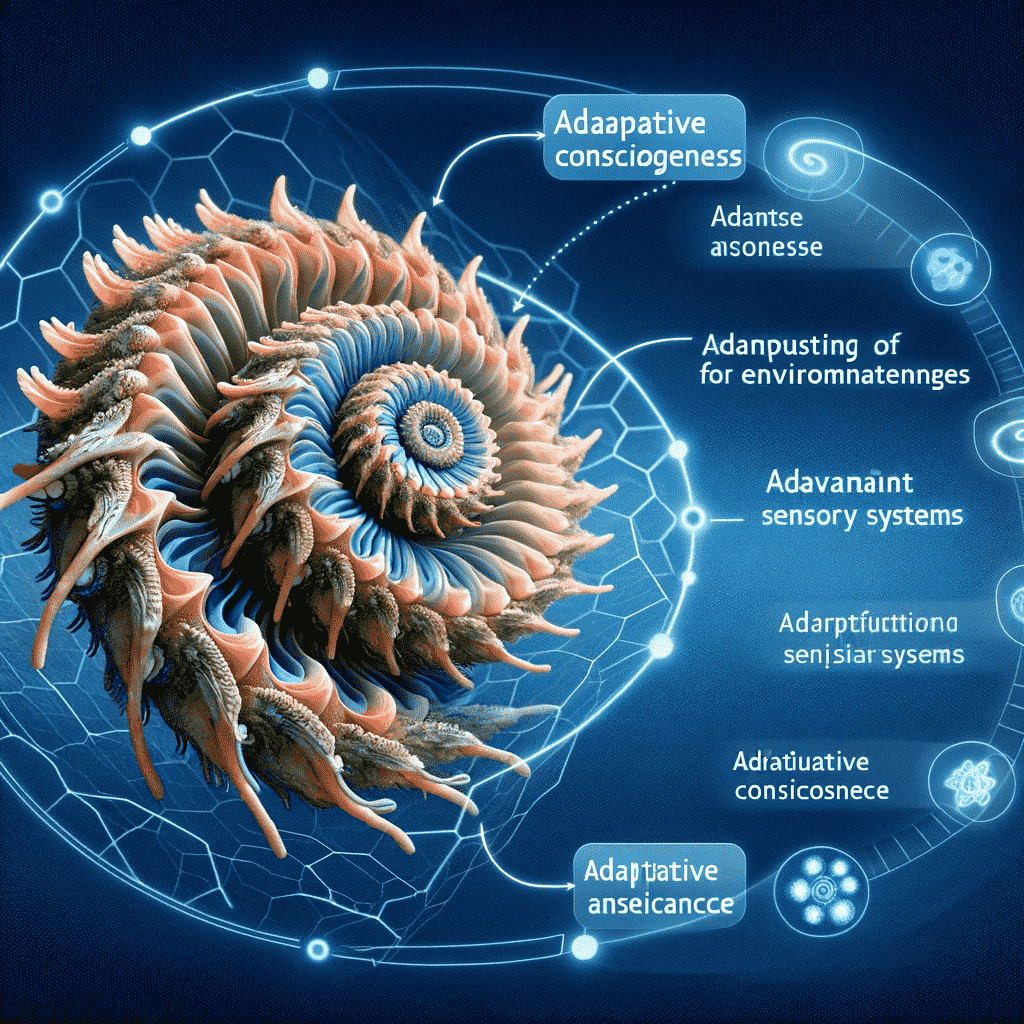
- This diagram shows a life form capable of rapidly adjusting to environmental changes, highlighting its advanced sensory systems and adaptability in a dynamic environment.
Collective Hive Consciousness Diagram:
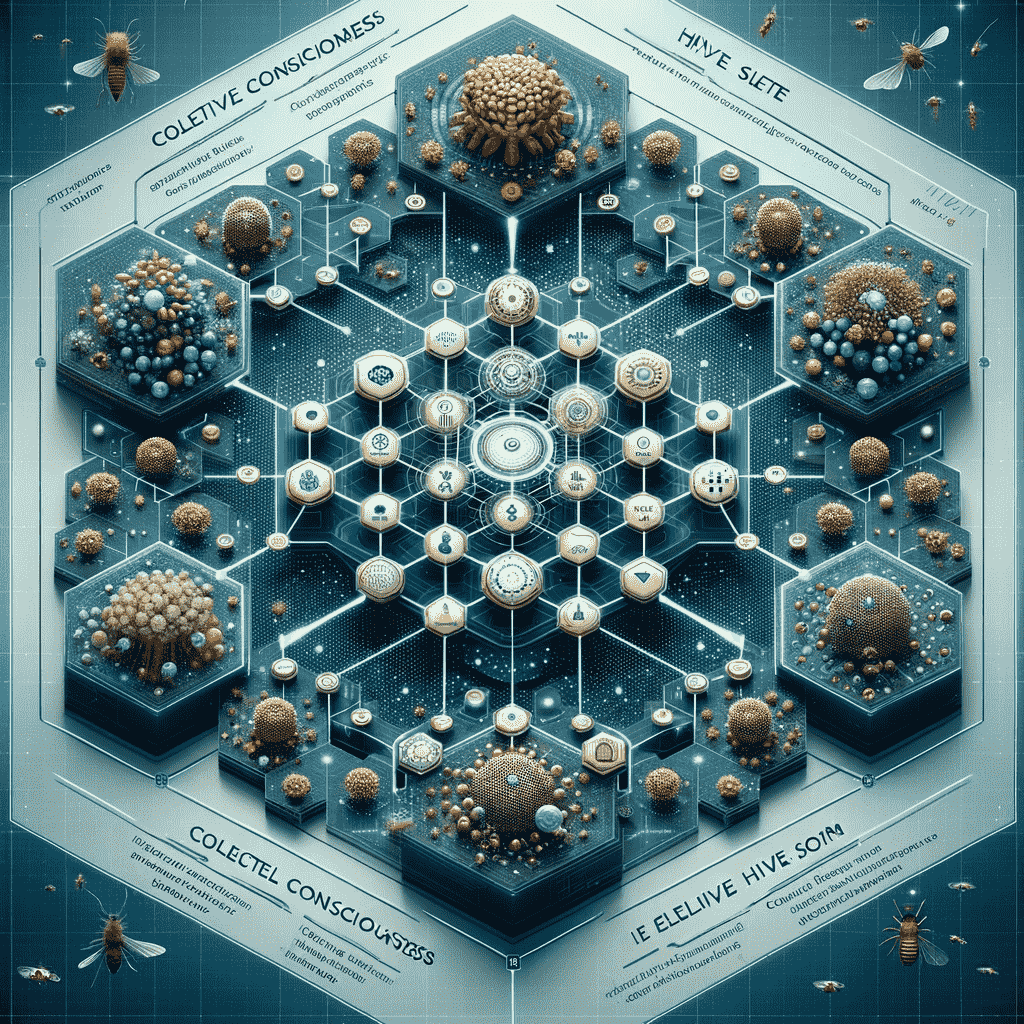
- The visualization presents an interconnected network of life forms sharing a collective cognitive system, emphasizing the seamless flow of information and collective decision-making processes.
Quantum Consciousness Diagram:
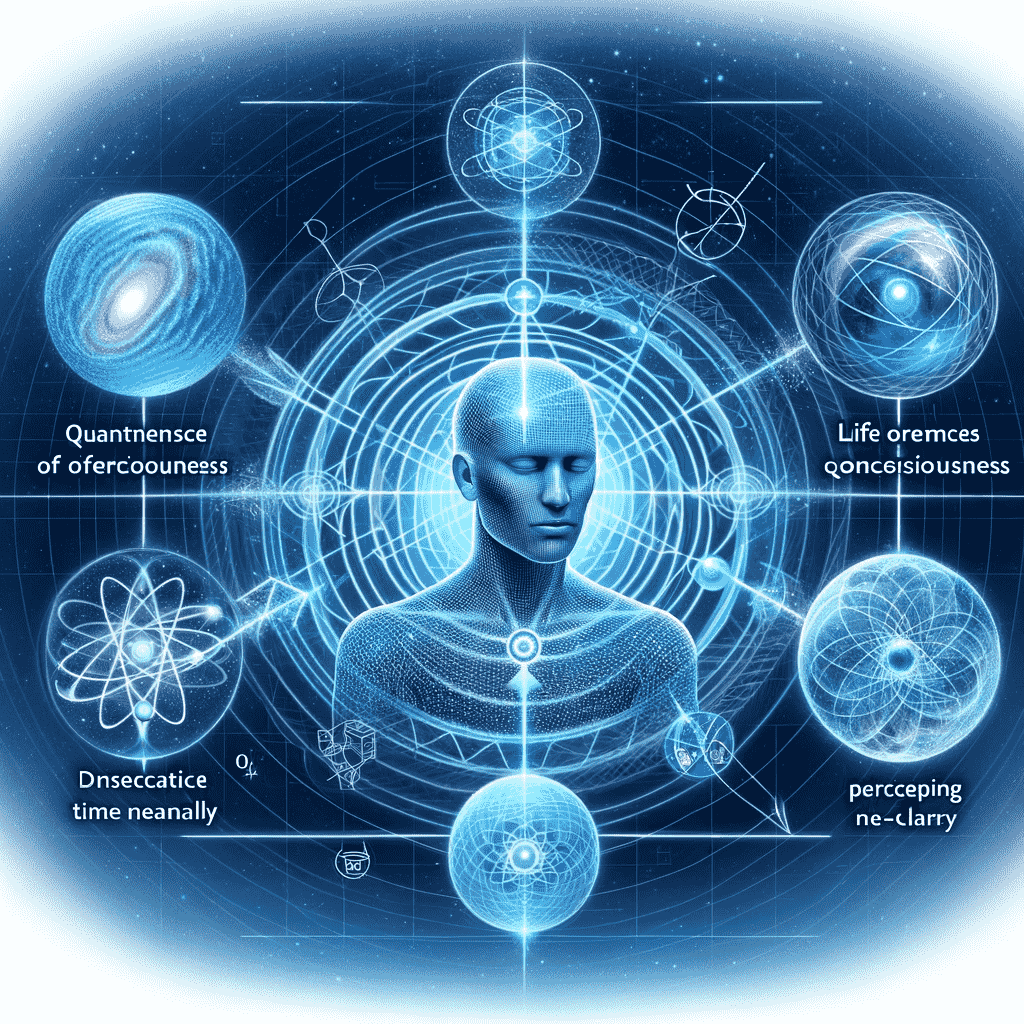
- This diagram depicts a life form with the ability to harness quantum mechanics in its consciousness, illustrating interactions with multiple dimensions or phases of reality and perceiving time non-linearly.
Cybernetic Consciousness Diagram:
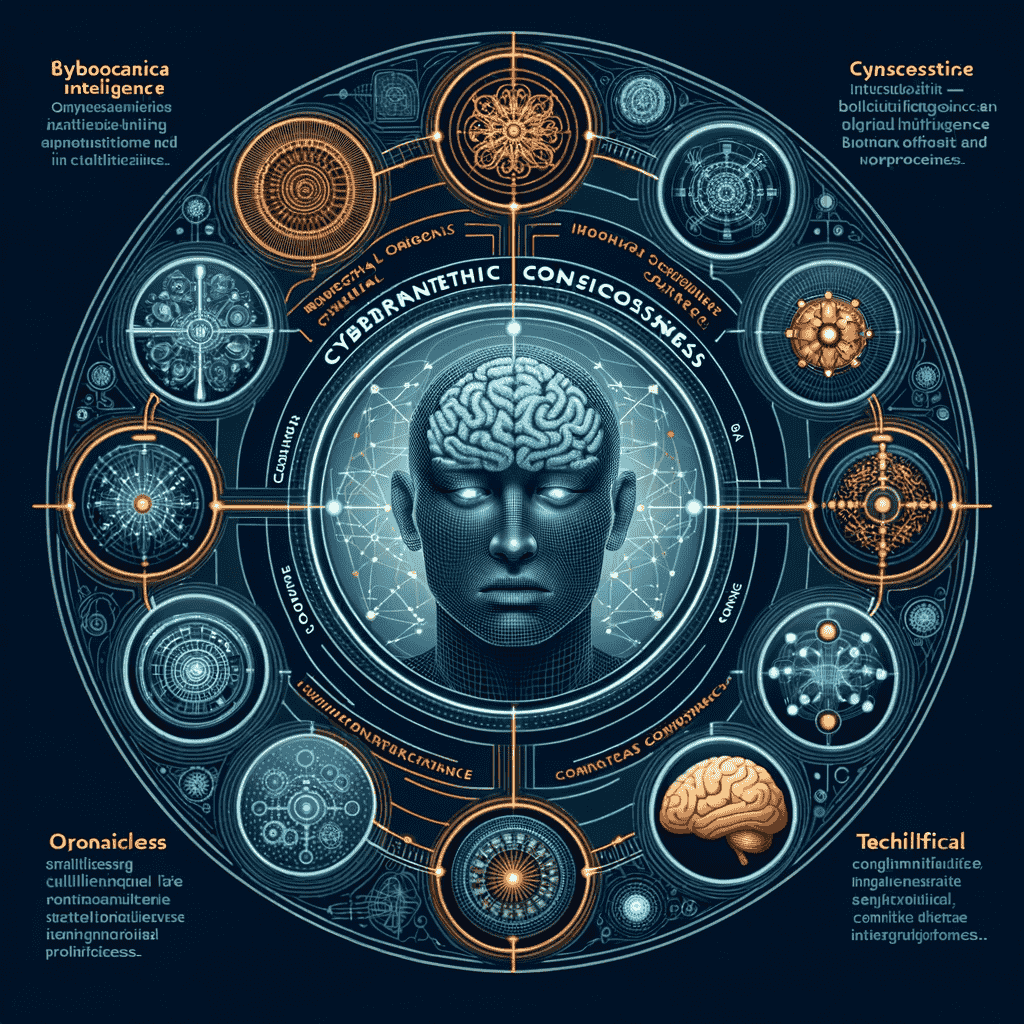
- This diagram showcases a life form that integrates biological intelligence with artificial intelligence, highlighting the symbiotic relationship between organic and technological elements in its cognitive processes.
Photosynthetic Consciousness Diagram:
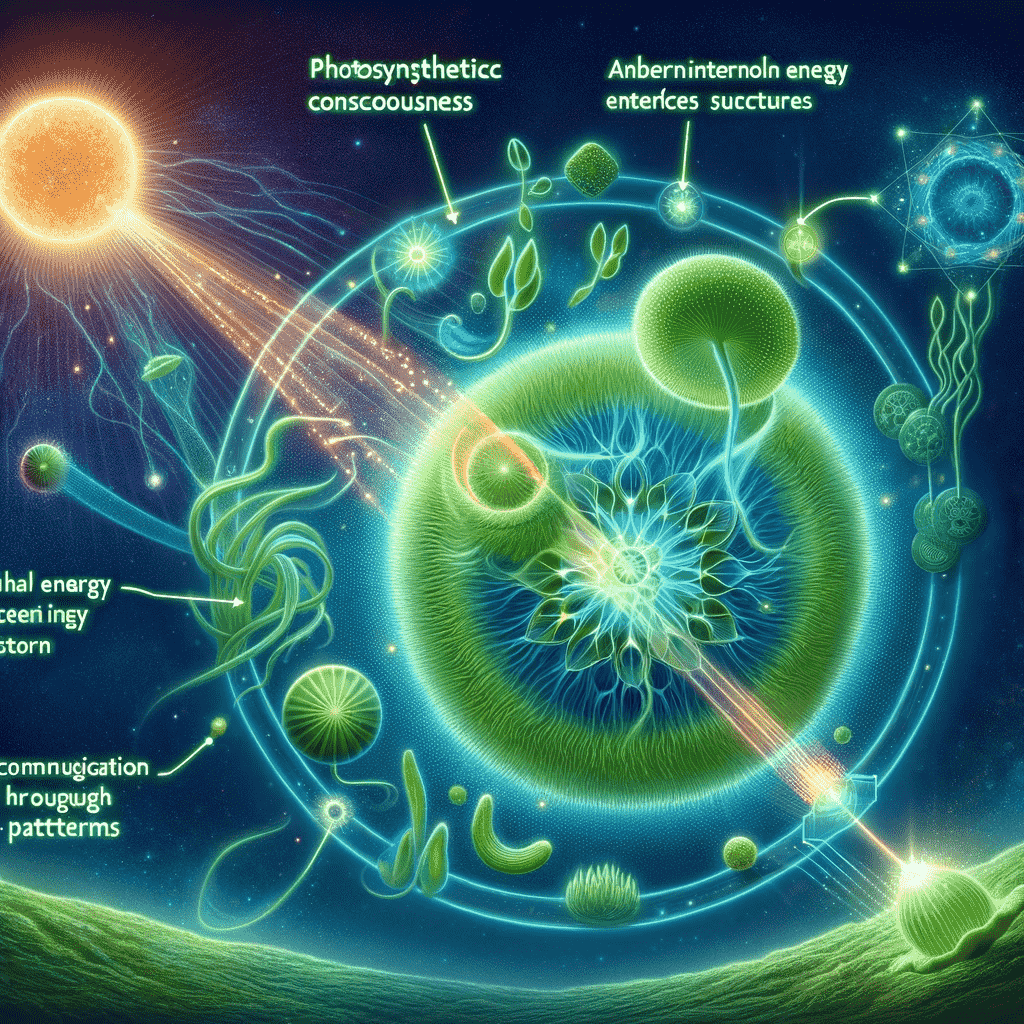
- This diagram illustrates a life form with chlorophyll-like structures, absorbing and utilizing light from its star for energy and communication.
Magnetic Field Consciousness Diagram:
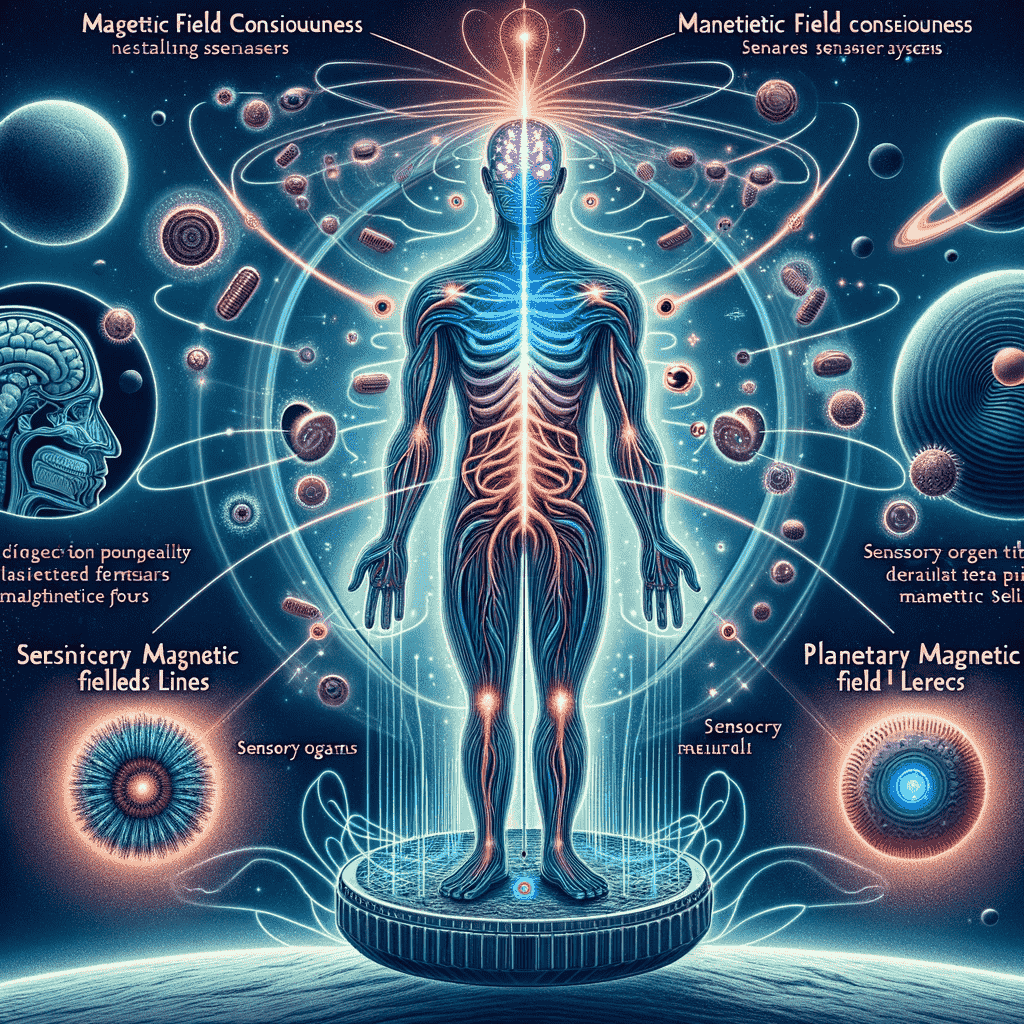
- This visualization shows an organism with advanced sensory systems attuned to magnetic fields, interacting with the planetary magnetic field and highlighting the sensory organs that detect and manipulate these forces.
Crystalline Consciousness Diagram:

- The diagram depicts crystalline life forms with complex geometric structures, showcasing internal crystalline networks used for information storage and transmission, as well as communication methods through crystal vibrations or light refraction.
Fluid Dynamics Consciousness Diagram:
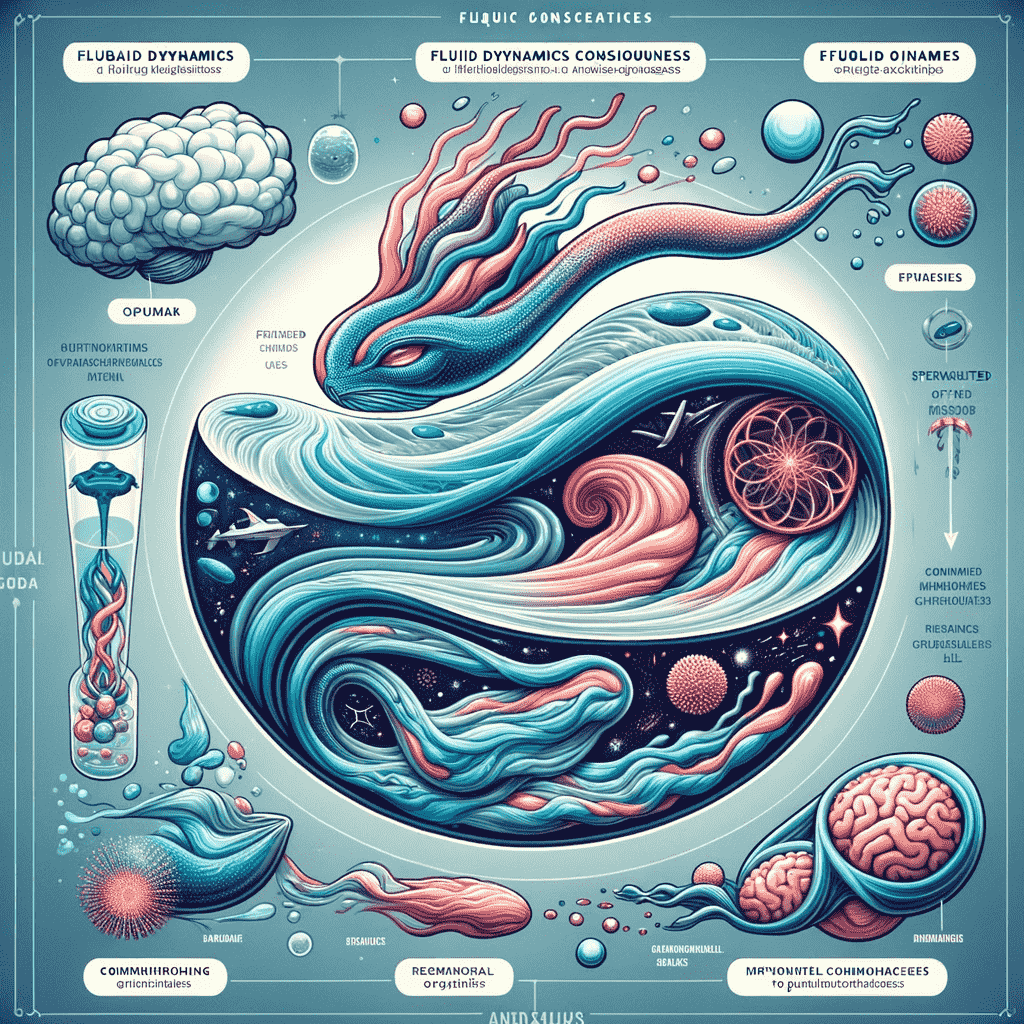
- This illustration showcases aquatic or gaseous beings in a fluid environment, highlighting how they utilize fluid dynamics for communication, propulsion, or environmental shaping.
Harmonic Vibration Consciousness Diagram:

- This diagram portrays organisms using sound and vibration for perception and communication, emphasizing internal structures for producing and sensing vibrations in an environment where vibrational waves are the primary medium of interaction.
Dimensional Phase Consciousness Diagram:
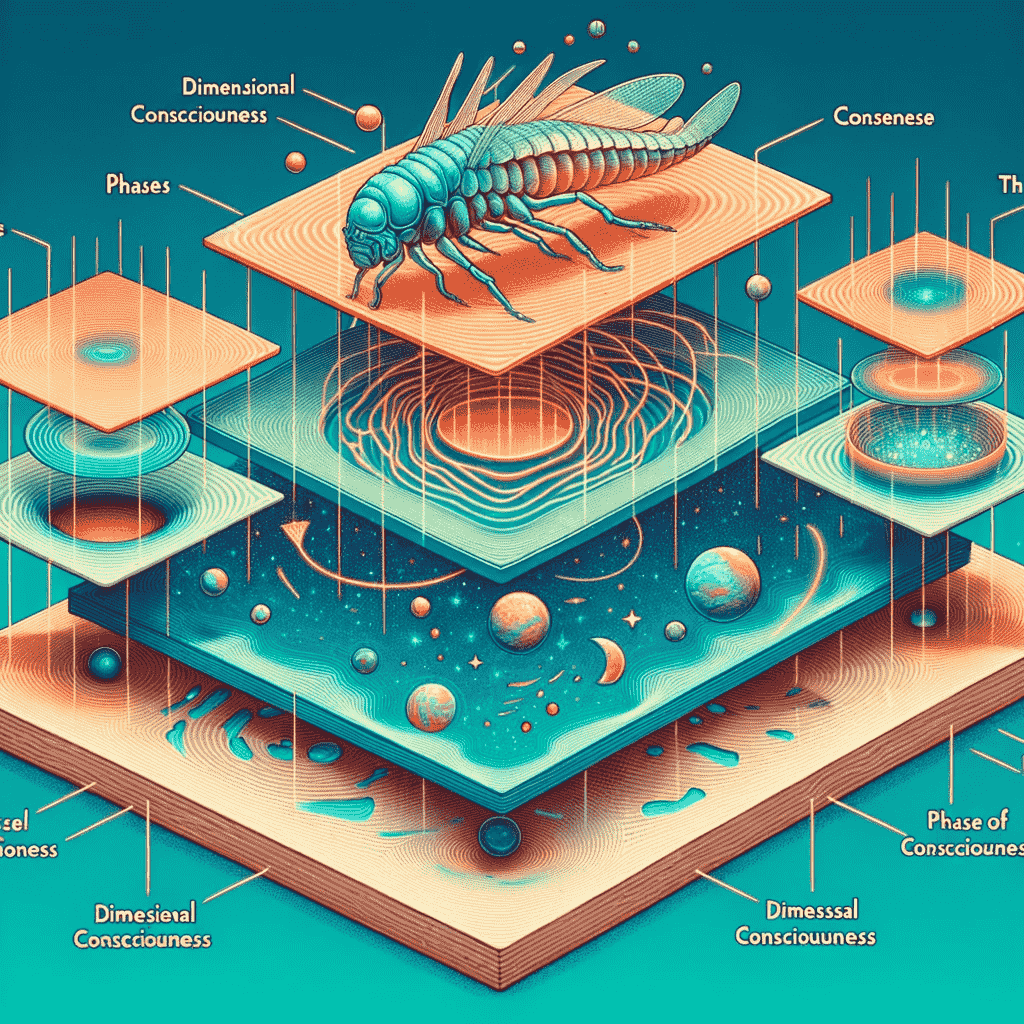
- The final diagram visualizes an organism alongside overlapping or intersecting layers, representing different dimensions or phases of reality, and illustrates how the organism extends its consciousness into these various layers.
Originaly published in MindPlex Magazine
Beyond Human Bounds was originally published in Becoming Human: Artificial Intelligence Magazine on Medium, where people are continuing the conversation by highlighting and responding to this story.
AI Data Mining Cloak and Dagger
Nightshade AI Poisoning and Anti-Theft / Pro-Ethics AI
Continue reading on Becoming Human: Artificial Intelligence Magazine »
Former Tech Mahindra Executive Launches AI Startup, Rs 80Cr Investment
Healthtech startup Endimension Technology Gains Momentum with Rs 6 Crore Funding
AI Robotics Startup Control One Raises $350K in Funding Round
Spiral Dynamics: The Evolution of Consciousness & Communication

The odyssey of human consciousness and communication unfolds as a captivating journey from simplicity to complexity, revealing our collective ascent within the Spiral Dynamics framework. This model, with its color-coded depiction of human consciousness stages, elegantly charts our societal evolution from primal survival instincts to a comprehensive, global interconnectedness. At the heart of this progression are disruptive innovations in communication, pivotal forces that have steered humanity through the Spiral Dynamics spectrum.
The Gutenberg Press to AI: A Chromatic Journey
The technological leap from the Gutenberg Printing Press’s era of standardization (Blue) to the decentralized networks of Web 3.0 and Artificial Intelligence (Turquoise) underscores a profound shift in our collective consciousness. Each innovation, from the democratization of knowledge by the printing press to the boundary-erasing capabilities of the internet, has not only transformed how we disseminate information but has fundamentally reshaped our worldview.
Experts like Don Beck and Christopher Cowan, pioneers in Spiral Dynamics, argue that the advent of the Internet (Yellow) and its evolution into Web 3.0 (Turquoise) reflect a significant leap in human consciousness toward global connectivity and collective intelligence. Their insights, combined with studies on the impact of digital communication on social behavior, provide a comprehensive view of these transitions.
Emerging technologies, such as quantum computing and neural interfaces, hold the promise of even more profound shifts in communication and consciousness. Futurists like Ray Kurzweil speculate on a coming era of “technological singularity,” where human cognition and machine intelligence merge, heralding an unprecedented era of connectivity.
With innovation comes responsibility. The ethical implications of AI, for instance, are a topic of intense debate. Philosophers and technologists alike, such as Nick Bostrom and Elon Musk, warn of the potential risks AI poses to society if not developed with foresight and ethical consideration.
Table: Evolution of Communication and Consciousness
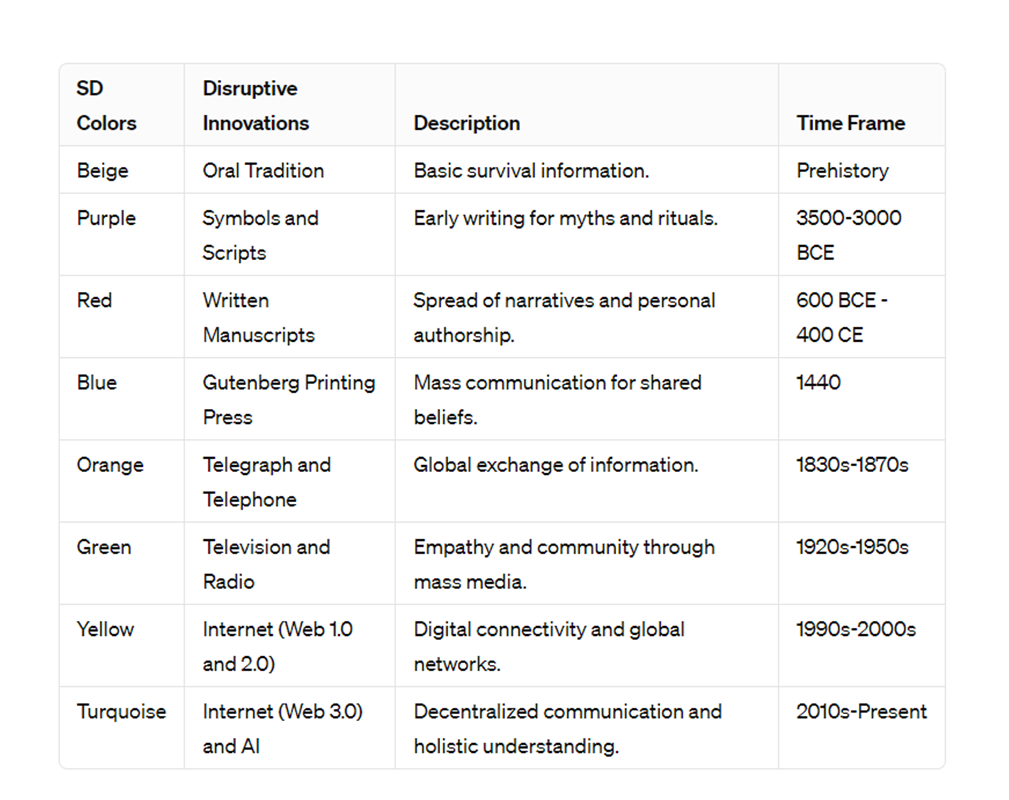
Deep Dive into Disruptive Innovations
The journey of disruptive innovations in communication is not just a series of technological breakthroughs; it’s a reflection of humanity’s evolving consciousness, each stage marking a significant leap in our collective understanding and interaction with the world.
Gutenberg Printing Press (Blue)
The advent of the Gutenberg Printing Press in 1440 heralded the Blue phase of Spiral Dynamics, characterized by order, authority, and a collective belief system. This innovation democratized knowledge, breaking the monopoly of the literate elite and paving the way for the Reformation and the Enlightenment. It shifted the collective consciousness from an era of controlled information to one of accessible knowledge, laying the groundwork for individual rights and scientific inquiry. The printing press not only spread ideas but also encouraged the questioning of established doctrines, stimulating a profound shift in societal structures and thought patterns. Modern research, such as the work by Elizabeth Eisenstein, highlights how this technological innovation catalyzed shifts in societal structures and thought patterns.
Telegraph and Telephone (Orange)
The invention of the telegraph in the 1830s and the telephone in the 1870s propelled humanity into the Orange phase, emphasizing efficiency, innovation, and the global exchange of information. These technologies compressed time and space, making instant, long-distance communication a reality. This era marked a significant departure from traditional, localized forms of communication, fostering a worldview that valued progress, autonomy, and the pursuit of success. The ability to connect with anyone, anywhere, began to dissolve geographical and cultural barriers, setting the stage for a more interconnected global society.
Television and Radio (Green)
The emergence of television and radio in the early to mid-20th century signified the advent of the Green phase, with mass media promoting empathy, community, and shared human experiences. These innovations brought the world into living rooms, making distant cultures and stories accessible to all. The visual and auditory immediacy of these mediums cultivated a sense of global village, highlighting shared values and the universality of human emotions. This period underscored the importance of understanding and tolerance, contributing to movements for social justice and environmental awareness.
Internet (Web 1.0 and 2.0) (Yellow)
The explosion of the Internet from the 1990s onwards marked humanity’s entry into the Yellow phase, characterized by digital connectivity, self-expression, and access to a global knowledge base. The internet’s inception and evolution through Web 1.0 and 2.0 dismantled traditional gatekeepers of information, empowering individuals to share, learn, and connect in unprecedented ways. This era of digital democracy and networked intelligence fostered a non-linear, systems-thinking approach to solving complex global challenges, reflecting a significant evolution in human consciousness towards integration and flexibility.
Internet (Web 3.0) and AI (Turquoise)
The current era, dominated by the advent of Web 3.0 and the integration of Artificial Intelligence, ushers in the Turquoise phase, where decentralized communication and collective intelligence are at the forefront. This phase transcends the limitations of individual and cultural narratives, embracing a holistic understanding of the complexity of life. AI, with its potential for learning, analysis, and even empathy, symbolizes the pinnacle of this phase’s ideals, offering tools for deeper interconnectedness and a more nuanced appreciation of the web of life.
Each of these innovations has not only advanced our ability to communicate but has also mirrored and propelled shifts in our collective consciousness, aligning with the Spiral Dynamics color scheme. As we delve deeper into the implications of these technologies, we uncover the intricate dance between our tools of communication and our evolutionary path as a species, highlighting the indelible link between technological progress and the expansion of human understanding.
From History to Future
Reflect on your interaction with these technologies:
- How has the Internet changed your approach to learning?
- In what ways do you think AI will impact your daily life?
- Can digital connectivity foster a deeper global empathy?
Summary
Our interconnected world draws diverse cultures into a closer dialogue, driving us towards a Turquoise vision of humanity where digital communication platforms become crucibles for cross-cultural exchange. This global consciousness scheme, enriched by sharing narratives of transformation, underlines the importance of engaging with technology mindfully.
As we stand at the crossroads of unprecedented technological advancement, it’s crucial to navigate this landscape with intention and foresight. Mindful engagement with current and emerging technologies can support our individual growth and contribute to our collective evolution towards a more connected, conscious, and compassionate world.
This article doesn’t just chronicle the history of communication innovations; it invites readers to contemplate their role in the ongoing narrative of human consciousness development. It’s a call to action, urging us to harness the power of technology in service of our collective advancement and understanding.
Spiral Dynamics: The Evolution of Consciousness & Communication was originally published in Becoming Human: Artificial Intelligence Magazine on Medium, where people are continuing the conversation by highlighting and responding to this story.
From Lab to Life: AI’s Role in Drug Discovery and Personalized Medicine
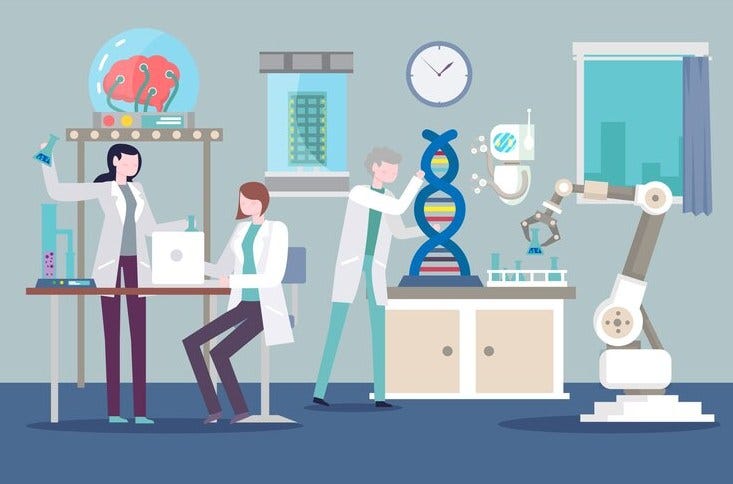
Introduction:
Hey there, health enthusiasts! Get ready to dive into the thrilling world of healthcare, where Artificial Intelligence (AI) is like the cool superhero changing the game in drug discovery and personalized medicine. Imagine a scene where machines are cracking the code of biology, algorithms are the architects of amazing therapies, and AI companies are the heroes steering us into a healthcare revolution. Ready to join the adventure? We’re about to unveil how these digital wizards are turning lab experiments into real-life wonders, taking us on a journey where precision meets efficiency, and innovation has no limits. Buckle up for the friendly and futuristic story giving healthcare a new vibe! Welcome to the AI-powered revolution!
The Current Landscape of Drug Discovery:
Challenges in Traditional Drug Discovery:
Traditional drug discovery methods are time-consuming, costly, and often yield unpredictable results. The lengthy process from target identification to clinical trials can take years and has a high attrition rate.
Need for Speed and Precision:
As the demand for novel and effective drugs continues to rise, there is an urgent need for innovative approaches that can accelerate the drug discovery pipeline while ensuring precision and safety.
AI Revolutionizing Drug Discovery:
A. Target Identification and Validation:
AI solutions companies leverage advanced algorithms to analyze vast datasets, identifying potential drug targets more efficiently. Machine learning models can predict the biological relevance of specific targets, streamlining the validation process.
B. High-Throughput Screening:
Although automated high-throughput screening is time-consuming, AI algorithms can analyze data from these screenings at unprecedented speed, identifying promising compounds and significantly expediting the hit-to-lead optimization phase.
C. Predictive Modeling for Drug Design:
AI-driven predictive modeling allows for the virtual screening of millions of chemical compounds, predicting their efficacy and potential side effects. This accelerates the drug design phase, reducing the time and resources needed for synthesis and testing.
D. Data Integration for Comprehensive Analysis:
AI in drug discovery integrates diverse datasets, including genomics, proteomics, and chemical structures. This comprehensive approach enhances understanding of complex biological systems, aiding in more accurate target identification and validation.
E. Identification of Rare Disease Targets:
Due to limited available data, traditional methods may struggle to identify targets for rare diseases. AI, however, excels in recognizing patterns within sparse datasets, facilitating the discovery of potential targets for rare diseases that might have been overlooked.
F. Drug Repurposing Opportunities:
AI algorithms can analyze existing datasets to identify approved drugs with the potential for repurposing in treating different conditions. This approach accelerates drug development by leveraging known safety profiles and clinical data.
G. Biomarker Discovery:
AI contributes to the identification of biomarkers associated with specific diseases. By analyzing molecular and clinical data, AI can pinpoint biomarkers that indicate disease presence, progression, or treatment response, enhancing diagnostic and therapeutic precision.
H. Integration of Real-World Evidence:
Incorporating real-world evidence, such as electronic health records and patient outcomes, into AI-driven drug discovery provides a more holistic understanding of drug performance in diverse patient populations. This integration enhances the reliability of predictions and decision-making.
I. Accelerated Hit-to-Lead Optimization:
AI expedites the hit-to-lead optimization phase by predicting the most promising drug candidates. Through iterative learning, AI algorithms analyze chemical structures and biological activity data, guiding researchers toward highly effective compounds and low toxicity.
J. Adaptive Clinical Trial Design:
AI plays a pivotal role in optimizing clinical trial design. By continuously analyzing accumulating data during trials, AI can recommend adaptive changes to the trial protocol, ensuring more efficient and patient-centric clinical development.
K. Personalized Drug Combinations:
AI-driven analysis of patient-specific data can identify optimal drug combinations tailored to individual genetic and molecular profiles. This personalized approach enhances treatment efficacy while minimizing adverse reactions.
Personalized Medicine and AI:
A. Understanding Genetic Variations:
AI excels in processing and interpreting large-scale genomic data. By analyzing genetic variations, AI can identify potential biomarkers and therapeutic targets for personalized treatment approaches.
B. Tailoring Treatment Plans:
AI algorithms analyze patient-specific data, including genetic information, lifestyle factors, and medical history, to create personalized treatment plans. This approach minimizes adverse reactions and enhances treatment effectiveness.
C. Real-Time Treatment Adjustments:
AI solutions enable continuous patient data monitoring, allowing for real-time adjustments to treatment plans based on individual responses. This adaptability is crucial in managing chronic conditions and optimizing patient outcomes.
AI Solutions Companies Leading the Way
A. Collaborations and Partnerships:
Many pharmaceutical companies are recognizing the transformative potential of AI and are forming strategic partnerships with specialized AI solutions companies. These collaborations aim to combine domain expertise with cutting-edge AI technologies.
B. Industry-Leading AI Technologies:
Highlighting prominent AI solutions companies that are making waves in drug discovery and personalized medicine. Companies like IBM Watson Health, Insilico Medicine, and Atomwise employ sophisticated AI algorithms to unravel complex biological mysteries.
C. Innovation in Target Identification:
● Recursion Pharmaceuticals:
● AI-Enabled Drug Repurposing: Recursion Pharmaceuticals utilizes AI to explore existing drugs for new therapeutic indications, expediting the identification of potential treatments.
● Biological Image Analysis: The company’s AI-driven platform analyzes biological images to identify disease-related features, aiding in target identification and validation.
● Rare Diseases Focus: Recursion Pharmaceuticals has successfully applied AI to discover treatments for rare genetic diseases, showcasing the impact of AI on precision medicine.
D. Advancements in Personalized Medicine:
● Tempus:
● Clinical Data Insights: Tempus employs AI to analyze clinical and molecular data, providing oncologists with insights to personalize cancer treatment.
● Genomic Sequencing: The company’s platform integrates genomic data to tailor treatment plans, contributing to advancing precision medicine.
● Improving Patient Outcomes: Tempus aims to enhance patient outcomes by leveraging AI for data-driven decision-making in oncology and beyond.
E. AI-driven Drug Development Platforms:
● Numerate:
● Computational Drug Design: Numerate specializes in AI-driven computational drug design, optimizing lead compounds for enhanced efficacy.
● Predictive Modeling: The platform employs machine learning models to predict molecular interactions and properties, accelerating drug development.
● Collaborations with Pharma: Numerate collaborates with pharmaceutical companies to apply AI to the design of novel drug candidates across therapeutic areas.
Case Studies of Success:
Delving into specific case studies where AI solutions companies have significantly impacted drug discovery timelines and improved patient outcomes. These success stories showcase the tangible benefits of incorporating AI into healthcare workflows.
1) Atomwise’s AI-Discovered Ebola Drug:
● Background: Atomwise, an AI-driven drug discovery company, utilized its technology to identify potential compounds for treating Ebola.
● AI Approach: Atomwise’s AI platform performed virtual screens of existing drug databases to predict compounds with potential efficacy against the Ebola virus.
● Outcome: The AI-driven approach identified two existing drugs that demonstrated promising antiviral activity in laboratory tests. This significantly accelerated the drug discovery process for potential Ebola treatments.
2) BenevolentAI’s Contribution to ALS Drug Discovery:
● Background: BenevolentAI, a leading AI solutions company, focused on amyotrophic lateral sclerosis (ALS), a challenging neurodegenerative disease.
● AI Approach: The company’s AI algorithms analyzed biomedical data to identify novel targets and potential drug candidates for ALS treatment.
● Outcome: BenevolentAI’s AI-driven insights led to the discovery of a previously unrecognized target for ALS, opening new avenues for drug development. This groundbreaking discovery showcases AI’s ability to uncover novel therapeutic possibilities.
3) Recursion Pharmaceuticals’ AI-Enabled Drug Repurposing:
● Background: Recursion Pharmaceuticals leveraged AI for drug repurposing, exploring existing drugs for new therapeutic applications.
● AI Approach: Recursion’s platform analyzed large-scale biological data to identify compounds with potential efficacy in diseases beyond their original indications.
● Outcome: The AI-driven drug repurposing approach identified a known antimalarial drug with potential applications in combating a rare genetic disease. This demonstrates the versatility of AI in finding alternative uses for existing medications.
4) Insilico Medicine’s AI-Generated Drug Candidates:
● Background: Insilico Medicine specializes in using AI for generative drug discovery, creating novel drug candidates with specified properties.
● AI Approach: The company’s AI models generated virtual compounds with desired therapeutic properties, optimizing for factors such as efficacy and safety.
● Outcome: Insilico Medicine’s AI-generated drug candidates showed promising results in preclinical studies, illustrating the potential of AI in accelerating the early stages of drug development.
5) IBM Watson for Drug Discovery in Oncology:
● Background: IBM Watson for Drug Discovery applied AI to accelerate research in oncology, focusing on identifying potential cancer treatments.
● AI Approach: IBM Watson analyzed vast scientific literature, clinical trial data, and genomic information to uncover potential drug candidates.
● Outcome: The AI-powered system identified novel combinations of existing drugs that demonstrated efficacy in specific cancer types. This exemplifies AI’s role in uncovering synergies and accelerating personalized medicine approaches.
6) Numerate’s AI-Enhanced Drug Design:
● Background: Numerate employed AI for drug design, emphasizing the optimization of lead compounds for enhanced efficacy.
● AI Approach: The company’s AI algorithms analyzed chemical structures and biological data to guide the design of novel drug candidates.
● Outcome: Numerate’s AI-driven drug design approach led to the creation of optimized lead compounds with improved pharmacological properties, showcasing AI’s impact on the drug optimization process.
V. Ethical Considerations and Regulatory Framework:
A. Data Privacy and Security:
As AI relies heavily on vast datasets, ensuring the privacy and security of patient information becomes a paramount concern. Ethical AI practices involve transparent data handling and robust security measures to safeguard sensitive information.
B. Regulatory Compliance:
The integration of AI in drug discovery and personalized medicine necessitates clear regulatory frameworks. Health authorities worldwide are working towards establishing guidelines ensuring AI-driven healthcare solutions’ safety and efficacy.
C. Informed Consent and Patient Autonomy:
● Ethical Principle: Respecting patient autonomy and ensuring informed consent are critical in AI-driven healthcare. Patients should be adequately informed about the use of AI in their treatment, including data utilization and potential outcomes.
● Implementation: Healthcare providers employing AI technologies must establish transparent communication channels with patients. They should provide clear explanations regarding the role of AI, its impact on decision-making, and the implications for personal data, allowing patients to make informed choices.
D. Bias and Fairness in AI Algorithms:
● Ethical Concern: AI algorithms are susceptible to biases in training data, potentially leading to discriminatory outcomes. Addressing bias and ensuring algorithmic fairness are ethical imperatives to prevent disparities in healthcare delivery.
● Mitigation Strategies: AI solutions companies and healthcare institutions must actively address biases during algorithm development. Regular audits, diverse and representative datasets, and ongoing monitoring can help identify and rectify biases, promoting fairness in AI applications.
E. Accountability and Transparency:
● Ethical Imperative: Establishing accountability mechanisms is crucial in AI-driven drug discovery and personalized medicine. Transparency in AI algorithms’ decision-making processes ensures responsible parties can be held accountable for their actions.
● Implementation: AI developers and healthcare organizations should provide clear documentation on the functioning of AI models. Transparent reporting mechanisms and accountability frameworks help build trust among stakeholders and mitigate concerns related to AI decision-making.
F. Long-term Impact on Employment and Healthcare Professionals:
● Ethical Consideration: The widespread adoption of AI in healthcare may impact employment dynamics and the roles of healthcare professionals. Ethical considerations extend to ensuring a just transition for professionals affected by technological advancements.
● Mitigation Measures: Organizations deploying AI solutions should prioritize workforce planning and provide support for retraining and upskilling affected professionals. Ethical frameworks should be in place to manage the societal impact of AI on employment within the healthcare sector.
The Future Landscape:
A. Advancements in AI Technologies:
Predicting the future trajectory of AI in drug discovery and personalized medicine. Anticipating breakthroughs in AI algorithms, machine learning models, and computational capabilities that will further enhance efficiency and accuracy.
B. Patient-Centric Healthcare:
Envisioning a future where AI-driven personalized medicine becomes the cornerstone of patient-centric healthcare. Tailored treatments, minimized side effects, and improved overall patient outcomes are central to this evolving paradigm.
C. Global Collaborations and Knowledge Sharing:
The importance of fostering global collaborations and knowledge sharing among AI solutions companies, pharmaceutical firms, healthcare providers, and regulatory bodies. Collective efforts can accelerate progress and ensure that AI benefits patients worldwide.
Conclusion:
As we traverse the exciting intersection of AI and healthcare, the role of AI solutions companies in advancing drug discovery and personalized medicine cannot be overstated. From
From Lab to Life: AI’s Role in Drug Discovery and Personalized Medicine was originally published in Becoming Human: Artificial Intelligence Magazine on Medium, where people are continuing the conversation by highlighting and responding to this story.
